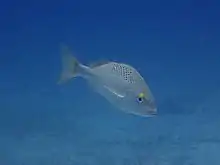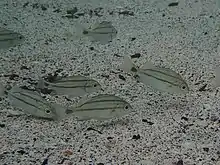| Haemulon scudderii | |
|---|---|
 | |
| Isla Santa Cruz, Galápagos | |
| Scientific classification | |
| Domain: | Eukaryota |
| Kingdom: | Animalia |
| Phylum: | Chordata |
| Class: | Actinopterygii |
| Order: | Perciformes |
| Family: | Haemulidae |
| Genus: | Haemulon |
| Species: | H. scudderii |
| Binomial name | |
| Haemulon scudderii Gill, 1862 | |

Haemulon scudderii, the grey grunt, golden-eye grunt, or mojarra grunt, is a species of marine ray-finned fish, a grunt belonging to the family Haemulidae. It is found in the eastern Pacific Ocean.
Description
H. scudderii has an oblong, compressed body with an oblique mouth, which has a projecting lower jaw, the lips are not fleshy and open below the centre of the eye. It has a continuous dorsal fin, which has a small to medium-sized notch in its middle. The dorsal fin contains 11-12 spines and 14*17 soft rays while the anal fin has 3 spines and 7-8 soft rays.[2] The overall colour is silvery-grey,[3] with each of the scales having a black spot on it,[2] with notably golden eyes. The inside of the mouth is normally orange in colour. The median fins are black while the pectoral and pelvic fins are a slightly lighter dusky colour.[3] The juveniles have a dark midlateral stripe that joins a black spot at the base of the caudal fin and a second stripe from the upper part of eye to upper surface of the caudal peduncle.[2] This species attains a maximum total length of 35 cm (14 in), although a length of 30 cm (12 in) is more typical.[4]
Distribution
H. scudderii is endemic to the eastern Pacific Ocean. It is distributed from southern Baja California and the central Gulf of California south along the coasts of Central America and South America as far south as Ecuador, its range includes the Galapagos Islands.[1]
Habitat and biology
H. scudderii is found at depths between 1 and 30 m (3 ft 3 in and 98 ft 5 in),[1] where it forms shoals around rock reefs in inshore waters wit some tidal movement.[4] This species is a nocturnal carnivore, preying on benthic invertebrates such as crustaceans, echinoderms, and molluscs, as well as small fish. It is a poorly studied species and little is known about its biology,[3] although it is oviparous and spawning is carried out in distinct pairs.[4]
Systematics
H. scudderii was first formally described in 1862 by American zoologist Theodore Gill (1837-1914), with the type locality given as Cabo San Lucas in Baja California.[5] The specific name honours American entomologist and paleontologist Samuel Hubbard Scudder (1837-1911), who at the time Gill wrote his description was studying the genus Haemulon with Louis Agassiz.[6]
References
- 1 2 3 Allen, G.; Robertson, R. (2010). "Haemulon scudderii". IUCN Red List of Threatened Species. 2010: e.T183487A8121901. doi:10.2305/IUCN.UK.2010-3.RLTS.T183487A8121901.en. Retrieved 11 November 2021.
- 1 2 3 "Species: Haemulon scudderii, Golden-eye grunt, Grey grunt, Mojarra grunt". Shorefishes of the Eastern Pacific online information system. Smithsonian Tropical Research Institute. Retrieved 1 April 2021.
- 1 2 3 "Mojarra Grunt". Mexican Fish. Retrieved 1 April 2021.
- 1 2 3 Froese, Rainer; Pauly, Daniel (eds.) (2019). "Haemulon scudderii" in FishBase. December 2019 version.
- ↑ Eschmeyer, William N.; Fricke, Ron & van der Laan, Richard (eds.). "Species in the genus Haemulon". Catalog of Fishes. California Academy of Sciences. Retrieved 1 April 2021.
- ↑ Christopher Scharpf; Kenneth J. Lazara, eds. (5 January 2021). "Order LUTJANIFORMES: Families HAEMULIDAE and LUTJANIDAE". The ETYFish Project Fish Name Etymology Database. Christopher Scharpf and Kenneth J. Lazara. Retrieved 1 April 2021.
